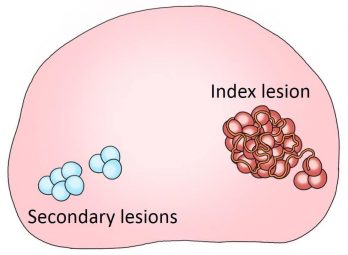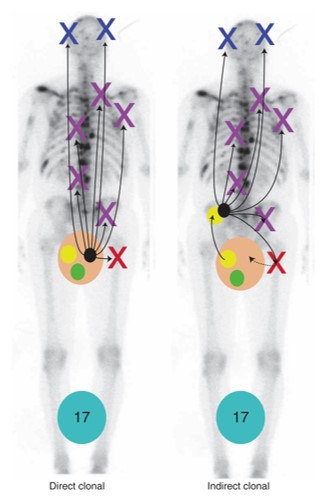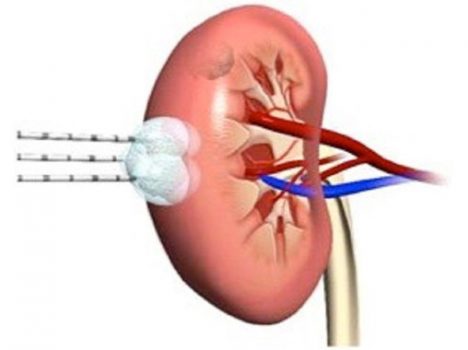Optional Treatments
Treatments > Optional Treatments > Focal therapy > The proof of concept
The proof of concept
Prostate cancer is known to be multifocal in 80% of the cases meaning the presence of different lesions into the prostatic gland (picture 52). When multifocal different studies have shown the existence of one main lesion so-called the index lesion (picture 53). Studies have shown that the metastatic disease spreads from one cell contained in the socalled index lesion (picture 54) [20, 21]. The index lesion is the most important in volume representing 80% of the total tumour volume and is responsible for the spread of the cancer outside the prostate (extra-capsular extension) in almost 90% of the cases [22]. The index lesion is the most aggressive lesion it contains the highest ISUP score and therefore leads the prognosis of the disease. The destruction of the index lesion leaves one or several secondary smaller lesions less aggressive with a better controlled risk of metastatic evolution. Unlike radical treatments, focal therapy does not aim to completely eradicate the cancer but to bring the disease backwards and to take control of the remaining lifetime (video 6). With the high-resolution technology (mpMRI, fusion biopsies) already available today to control accurately any progression of the disease it is possible to consider at least Low Risk and favourable Intermediate Risk prostate cancer suitable for this innovative management. If a small lesion tends to grow it could be followed by active surveillance and when necessary the lesion will be targeted by focal therapy leaving behind smaller lesions. This scenario can be repeated endlessly with the perpetual improvement of technology and its increased accuracy.

Picture 52 : Multifocal prostate cancer with a more important lesion of the right lobe


Picture 54 : Metastatic spread of the disease starting from the index lesion (in black) while the other lesion plays (yellow and green) a secondary role. The mechanism of metastasis spread is either direct from the prostate or indirect by a first metastase which will latter spread. (source : Liu W. Nat. Med. 2009)
Video 6 : The proof of concept of focal therapy based on the index lesion
The precedent of partial nephrectomy
Regarding the impact of the multifocality on the prognosis of the disease the precedent of renal cancer is very interesting. When the CT scan has been able to localize accurately the lesions of a renal cancer into the kidney the idea came to remove only the visible lesions and often only the most important one (partial nephrectomy). The adversaries argued that the renal cancer was a multifocal disease and a such the whole kidney should always be removed despite the risk of renal impairment. Twenty years later and despite some resistances nowadays more than 80% of cancer renal surgery is conservative by partial nephrectomy. When the lesion is below 3 cm it is even possible to choose a percutaneous minimally-invasive approach without surgical ablation by using an energy (microwave, cryotherapy, electricity) to destroy the tumoral lesion (picture 55). Noteworthy at 1 cm from the perineal skin the prostate is far more easy to reach than a kidney and with lesser risk.



